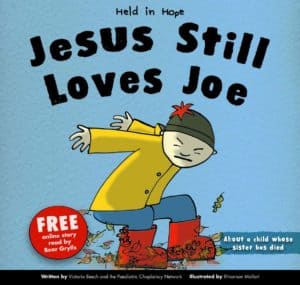Last week a tragedy happened in a town near us when two young boys were killed in a hit-and-run. One mother whose daughter knew the boys contacted me asking if I knew of any resources to help them. As it happens, we’ve had a family bereavement this week, as my Grandad died at the age of 97. Two very different deaths, but as I’ve told my children when they ask about degrees of sadness based on the age of the person: It’s always sad when someone dies.
And it’s difficult to grieve with children!
Despite being something we will all face, death isn’t something we want to dwell on and not something many people chat with children about until it’s necessary.
Before I had children, I co-authored the Held in Hope series of books aimed at Christian children aged 3–6 years, exploring experiences of sickness and death and drawing on what the Bible says about them. The expertise on grieving came from the chaplains in the paediatric chaplaincy network, especially those at Birmingham Children’s Hospital. They are an incredible team, who deal gently, graciously and spiritually with people in the midst of sickness and death.
When we wrote these books, I recommended people read them with their children before they had a need to chat about death, and so when my girls were 2 and 3 I decided I should take my own advice! At first, I thought they didn’t really get them, as they seemed to take them in just like The Gruffalo or The Highway Rat. However, a few months later we had a surprising conversation:
3yo: Mummy, there’s no pain in heaven, is there?
Me: No. [surprised and delighted that one of the things in the Jesus Still Loves Joe book has obviously be heard!)]
2yo: Yeah, Jesus, he wipe all the pain away like wiping up milk.
Me: [stunned pause] [makes mental note of this deep theological response]
As my friends’ children reached about the age of 3 or 4, many of them, knowing I’d worked on the Held in Hope project, started to ask me how to talk with their children about death, as their children were asking them questions. This was usually not in response to a family bereavement, but just as part of their curiosity about all things. I know it’s tough, and it’s among many other good topics to chat about, but I really do think it’s a wise idea to get talking about death before we need to, if only because when we need to it’s often hard to talk at all!
Three years after we first read Jesus Still Loves Joe, my children have just experienced for the first time, the death of someone they knew. My now 6yo told me today that it’s harder when someone you know dies, as you have memories. She’s not wrong. I am so sad, and it’s really hard to have good conversations when you’re trying not to cry!
We’ve had some very deep conversations about death, heaven and hell, burial and cremation, funerals and what people wear. In the middle of these conversations, my 6yo told me:
“You know Mummy, just before Great Grandad died, I think Jesus came into his room and took away all his pain, anxiety and weakness and made him just like us. Then He made a shaft of light so that he could see all the pictures of his family on the wall.” What a beautiful picture, and how amazing to be comforted in my time of sadness by my daughter. It’s been so hard but so good to be able to continue our chats about death and grief, and so meet God in the middle of them. I hope these resources help you to do the same.
Books and videos:
The Held in Hope books are all aimed at children aged 3–7 years old, and address sickness and death from a Christian perspective. There is no heavy theology just addressing issues that young children have, rather than those we adults wrestle with. The two books from the series which are most helpful for chatting about death and grieving are:
Jesus Still Loves Joe – a book about a child whose sister has died, which explores many different ways grieving looks and feels, especially as a child, and how we are always loved by God no matter how we feel. The pictures are especially helpful – we tried to tell as much of the story as possible in the pictures, and only use text for elements we couldn’t get across visually. If you have children who are grieving, it would be helpful to chat through the images and see which ones they associate their own emotions with. It also has a very positive message: however we feel or respond to bereavement, we are still loved.
Sam’s Special Book – a book about a child who is going to die before they are an adult. It explores the concept of heaven through the verse: “I am going to prepare a place for you. In my Father’s house are many rooms.”
We worked hard to make the books answer questions young children have, and there are a series of online films of each book as well. This is helpful for parents who might struggle to know how to even begin a conversation about sickness and death with their child. These conversations are particularly tricky when we’re grieving ourselves.
Activities
Things we’ve done are:
- making space in our schedule for downtime, which allows time for conversations, crying and feeling sad
- watching Inside Out, a movie in which we discover that sadness is an important part of life (and there’s that really sad bit where BingBong dies which gave us a good chance to sob!)
- read The Paper Dolls, chosen by my 5yo, which is a secular book written by Julia Donaldson that really expresses the sadness of loss and the preciousness of memories in a beautiful way. I’ve used this to explore grief in workshops, and this week when my daughter chose to read it, she found the wondering questions I’d written in the back, such as I wonder which part of the story you like best. I wonder which part of this story could be about someone you love dying. I wonder what part of this story is a bit like Jesus. She found these surprisingly easy to answer and they gave her an opportunity to talk about death and loss, Jesus and heaven in a profound but very childlike and appropriate way.
One of the things we intentionally put into the Held in Hope books are good grieving practices, including the following:
- a memory box – a small cardboard box with items which remind you of the person
- a candle – to light and remember them
- a tree to plant to remember them (this could also be any perennial plant)
- spending time being sad and comforting each other
Here’s a simple activity from Sam’s Special Book which you could do at any time, exploring Jesus’ words in John 14:2 “There are many rooms in my Father’s house. I wouldn’t tell you this unless it was true. I am going there to prepare a place for each of you.”
The activity is quite simple: we imagine what our room might be like.
Create a house (the size will depend on how many people and how many rooms you want in it). If you’re doing it in your family, you could just tape 4 A4 sheets together and draw a large house across them. Paint a red roof on it or cut a sheet of A4 red paper in half long-ways, cut off the corners, and attached it on the top as a roof. Cut A6 pieces of white paper to be the rooms then spend some time imagining and creating your rooms in ‘God’s house’ which Jesus spoke of in John 14:2. I’ve found that as we do this, is allows us to have hope in a time of sadness, to imagine heaven and the place the person we miss is now, and to anticipate with happiness meeting Jesus and living with God forever.
More resources
Annie Wilmot is a Christian parent who takes funerals, and also blogs at Honest Conversations wrote this great post and here’s a podcast by her on Parenting for Faith
Here’s a link to some articles on Parenting for Faith about death, including one called: What do you do when you and your toddler come upon a funeral procession?
You can get more information about the resources and services that Care for the family provide for bereaved parents and children here.

